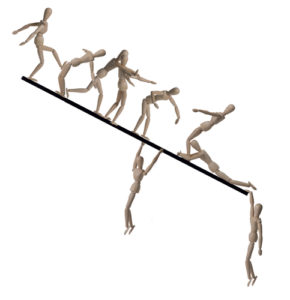 Laban invokes infinities in the directional variations of the movement of human limbs in the space surrounding the body. But he also identifies limits to the shapes the limbs can trace in space.
Laban invokes infinities in the directional variations of the movement of human limbs in the space surrounding the body. But he also identifies limits to the shapes the limbs can trace in space.
There are two types of limits that impact bodily movements in space. The first is the gravitational field in which we live. Due to this force field, only certain spatial trajectories allow us to maintain stability and balance, while other directional pathways are destabilizing, projecting us through space or causing us to fall.
In addition, the proportion of our limbs, the structure of our joints, and our angular range of motion dictate the kinds of patterns our actions can trace in space. Complicated actions, such as touching a point on the floor behind us, employ a number of contributory movements from many parts of the body. According to Laban, these “contributory movements also have a limited range which is determined by the degrees of their angles.” Unless these limits are respected, “we shall succeed in reaching the desired point only by means of incredible distortions and with the greatest difficulty.”
